We’ve gone through a little thinking about Homestead Disaster Planning at the Firefly. We are actually homestead wannabes. Conditions at our place are very guest friendly. But, because of recent storms, we have gone through our list of preps because we want to be prepared in case something unexpected happens.
https://www.instagram.com/p/CnV1jJMh9ul/?utm_source=ig_web_copy_link
Historical Background
We have a little section on natural disasters in the About Your Stay page. The Firefly is indeed a very pleasant place to come and spend a weekend. The main weather related disaster for us has been humidity, which we normally get during the summer.
But, in December and January, we have had incidences of tornadoes and power outages which are very unusual. The last time anything like that happened in the area was about 10 years ago. So for the purposes of guest safety, we’ve reviewed some of our preparations.

The modern “homesteaders” by the way are a very hardy crew that we respect. There is an entire culture of people who are trying to be closer to the land, do subsistence farming, and use small scale sustainable agriculture techniques, some of which is very sophisticated.
We don’t really pretend to be homesteaders, but we do have some commonalities. We always thought of ourselves as being aware of the local environment. We’ve done some work on food foraging, chickens, and edible landscaping.
It is part of a practice we call “human scale living”.
Homestead Disaster Planning: Hypothetical Disasters
Let’s just say that the list of hypothetical disasters here are different than what you would get in Minnesota. It very rarely gets cold here. We had a very unusual December cold snap that got temperatures down into the low teens. But it only lasted a day or two, and there was no significant ice involved.
Also, let’s also specify that we’re talking about how to get through a two or three day period where there are local scale disasters that might cause us problems.
We will touch on some of the things we are doing to be self sufficient on food and other supplies. We can talk more about how to be self sufficient over the long run.
Meanwhile let’s keep it simple.
Water
The water supply at the Firefly is local city water from the City of Madison, and is quite good. We have never had a service interruption and the kind people at the city called us one day when we were watering some newly planted trees to see why we were using excessive water.
But, if we were in a situation where we had to rely on stored water, this might be an issue. We’ve linked below the FEMA water storage guideline PDF. They propose that we store one gallon per person per day, and suggest that enough water be on hand to for two weeks.
So if we had a crew of two, plus four guests, that’s 6 gallons per day usage, and for a three day supply, we’d be talking about 18 gallons of water.
According to the source below, bottled water is good for at least two years, so it would be fairly simple to keep four of those five-gallon water bottles hanging around the place for emergencies.
Alternate Water Sources
Historically, our Homestead Disaster Planning Strategy at the Firefly has been how to deal with too much water. But at some point, if we were to experience systemic issues, we have other ways to access free water from various sources.
There is also an “abandoned” well on the property, which we believe was shut in at or near the time the city water arrived. If anybody that knows this place can tell us where the well is, so we can potentially revive it, we would appreciate it.
Actually there are a couple of little farm lakes near us, which tells us that there is a source of sub-surface water, if we were to have to access it.
Hopefully we will never get to the point of drinking our fish pond, which is about 100 gallons.
Homestead Disaster Planning: Food
The FEMA guide below is not specific as to how much food to keep on hand.
It does give a useful order of operations as to how to eat it though.
At the beginning of a power failure issue, they suggest we have a party, and start to eat perishable food. When that runs out, start on the food in the freezers, which we have a couple of big ones of.
The FEMA guide also suggests a respectable supply of dry ingredients including pasta, rice and grains. We generally try to keep low-carb, but in this case it makes sense to have a few items like that around the place.
Special Dietary Issues
For those who have been around long enough to remember fallout shelters, there is a lesson in history. The fallout shelters were all equipped to carry 700 calories per person for two weeks.
One of the main products that was kept in the place was crackers and peanut butter.
Now, however, because people are gluten and peanut intolerant, this may not be practical. Therefore the modern homesteaders are aware that some people have special dietary considerations, and this is a potential issue. At our place we accommodate a lot of different dietary situations, but being cooped up in a disaster situation with peanut butter is a possibility.
We will have to put this on our to-do list, which we will start below.

Longer Term Food Security
We’re actually in pretty good shape for our hypothetical three day disaster with six people. In fact, our onsite supply of adult beverages and a freezer full of pork might constitute a party.
In the unlikely event of a bigger disaster, or long term food supply issues, we have our options. We’ve made a bit of a study of hugelkultur gardening, food foraging, sweet potato farming, and other local foods.
We also have some edible landscaping.
So, depending on when the disaster hits, we are probably good for awhile. Over the long term, we are thinking about getting a few more “converters” who convert weeds into protein.
We can do this because we are in the country.
We’ve also experimented with chicken tractors, and for the most part, this has been a successful way to feed the chickens and contain them at the same time.

Homestead Disaster Planning: Energy
This place has three indoor fireplaces, along with a fire pit and outdoor fireplace. Also, we feel we have a practically unlimited supply of firewood for cooking. Since it never gets too cold here, we feel no issues with short term cozy fireplaces.
In fact, this is another situation where if we thought the disaster was going to be short term, a party might break out. A freezer full of food, adult beverages and cozy fireplaces could be fine, depending on the time of year.
The local electrical supply is Walton EMC which has also been typically very reliable. This is a local co-op situation, not completely government owned.
We do have one vulnerability though, the electrical power supply does run a sump pump we have in the basement. Since the main house is at the bottom of a slope, the basement is kept “dry” by a sump pump which pumps the water out during big rain events.
So you could see a situation where we would want to ensure a backup supply of electricity, to keep this pump running. This can be accomplished with a car battery and a cheap inverter from the local cheap tool store:

According to this video, these little inverters can be used to temporarily power a gas furnace, which we have in the main house.
Electricity in the Guest House
Everything in our guest house runs on electricity. We can potentially supplement the power in the guest house with a generator, and of course, the amount of expense, fuel and installation cost might make this prohibitive from a business standpoint.
Solar: We have looked into this. Walton EMC is very good about generating and delivering reliable power. Their service is such that outages are rare and short.
But, they are totally unfriendly when it comes to solar, and refuse to buy back solar power from the grid. Also there are a lot of zoning restrictions in Morgan County that forbid or highly regulate use of solar in residences. What that means is our off grid dreams of a solar empire will have to be financed from our book sales rather than capitalizing on power generation as a revenue source.
Also, if the disaster is a hurricane, which happens during the warm time of year the pleasantness of the electricity-free party will be lessened.
At least we can work on a battery cell phone charger.
Fuel
We are about three miles from town, and the maximum amount of fuel we typically have around the place is enough to drive the lawn mower. Storing a lot of fuel around the place is not really that great of a plan. We could try to make sure to have enough for a couple of carloads of guests to get to Covington if needed.
We do have a fleet of experienced bikes, however, and we have already experimented riding around the area on one or more of them. If a trip to town is needed, this is an option, depending on the nature of the disaster.
Hurricane and tornado bike riding is not all that great, as was found out in 1939.
Security
We have shared some of the recent crime statistics in a previous article. Morgan County has one of the lowest crime rates in the state.
So in a disaster situation, we don’t really expect for there to be a descent into chaos, especially since our place is a couple of miles into town. We have huge guard dogs that were bred to keep out the riff raff.
Is it possible that a huge, foraging army could storm through the countryside, stealing as much food from us as possible? In fact, that exact thing happened one time in the past, and it is our guess that there will be a warning if it were to happen again.

The local law enforcement people are typically good at keeping order. Within the last couple of years there has been some encroachment of disorder.
The best course of action is to help maintain this by being a part of the community, and helping each other out. So we’ve put this as a to-do item.
Homestead Disaster Planning: Personal Factors
In this era, society has pretty much done away with discomfort. You ride your heated or air conditioned car, to within a few feet of your destination. Food of various types unheard of in history is available at arm’s length.
Your communications ability is better than all the kings of ancient Rome.
But, could you walk the two miles to town in a disaster? You’d better be in shape to do so. So, that is actionable. Get and stay in good enough condition to make it some distance on foot.
Also, keeping and maintaining a big set of tools, having medicines on hand, and maintaining a spare set of eyeglasses, if you wear them, might be very useful as well.
Most important is the preparedness mindset, which is to spend some time thinking about some of these issues, and increasing your tolerance for discomfort.
There is an article below about how to understand “psychological preparedness” and learn to cope with potential highly stressful situations. It is said that it is one thing to prepare physically but there are often failures in mental preparedness.
There is a second article about the preparation of a “72-hour kit” which, in an of itself, can reduce anxiety and let you think clearly in the event of a disaster.
Alternate suggestion: “camping” can be thought of as a 72-hour discomfort event, and some consideration might be given to trying that.
Homestead Disaster Planning at the Firefly
Well, on the whole, the idea of Homestead Disaster Planning at our place is fairly straightforward. We could certainly cope with a couple of days’ disaster and have some potential for putting in some extra effort into some disaster preparedness.
Please feel free to contribute any new ideas or ways to improve this list of items.
Homestead Disaster Planning: To Do List
| Issue | Action Item |
| Water Storage | Look into increasing bulk water supply |
| Water Storage | Where is the old well on the property? |
| Water Storage | Rainwater Collection Options |
| Food | Should we accommodate special dietary issues? |
| Food | Further work increasing onsite garden and food supplies (more gardens) |
| Electrical Supply | Need power inverter and a few extra car batteries |
| Electrical Supply | Look into alternate ways to power the guest house |
| Fuel | Inspect bikes and get them road worthy |
| Fuel | Consider some increased fuel storage (and best ways to store it) |
| Security | Network and support community security |
| Personal | Work on improving conditioning, and tolerance of discomfort |
| Personal | Organize first aid kit, basic supplies, and a 72-hour kit. |
| Personal | Go camping at some point |
Links and References
FEMA food and water storage
https://www.fema.gov/pdf/library/f&web.pdf
Shelf life of bottled water
Civil Defense Museum
Tolerance for Discomfort
https://www.preventionweb.net/files/66345_f357zulchpsychologicalpreparednessf.pdf
Deschutes County Disaster Prep
Mother Earth News
![]()
